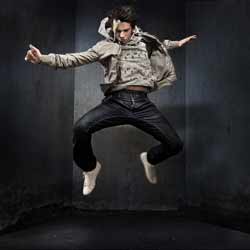Learning Hip Hop and Modern Dancing
Modern Dance
Modern dance was born in the early 20th century as a form of rebellion against the rigid constraints of ballet. As opposed to the limited, strict movements of ballet, modern dance is thought of as a relaxed, free style of dance that encourages personal expression. Dancers use their emotions and moods to design their own steps and routines. It is not unusual for modern dancers to invent new steps for their routines, instead of following a structured code of technique, as in ballet. Modern dance is typically performed in bare feet and non-traditional costuming.

Another characteristic of modern dance in opposition to ballet is the deliberate use of gravity. Whereas classical ballet dancers strive to be light and airy on their feet, modern dancers often use their body weight to enhance movement. Modern dance movements work with the deliberate use of gravity instead of attempting to constantly defy it, as ballerinas do. Modern dance makes use of the floor, where dancers roll, stretch, lay down or move across the floor. A modern dancer rejects the classical ballet stance of an upright, erect body, often opting instead for deliberate falls to the floor.
Modern dance has evolved over the years since it was first pioneered. Isadora Duncan, Ruth St. Dennis, and Martha Graham are all familiar names that made great contributions to this contemporary form of dance. Graham developed her own personal style and technique that sought to use dance as an expression of common human emotions such as joy and rage through specific movements, such as contraction and release. Her technique made her one of the foremost modern dance pioneers in America. Other choreographers such as Jose Limon, Merce Cunningham, and Paul Taylor have continued the tradition of modern dance.
Hip Hop Dancing
Hip hop dance is closely associated with hip hop music and has a very specific vocabulary of dance moves, which fall under a range of styles known as breaking, locking and popping. It appeals to many people because it is both fun and physically demanding. Hip hop dance evolved along with hip hop music, in the 1970s within groups of African American street gangs from the streets of South Bronx and Brooklyn, NY. Hip hop dance is often performed in groups, or crews, where freestyle choreography is encouraged, and formal or informal dance battles, or competitions of showmanship, are a way of proving prowess.
Dance battles occur within a cipher, or circle, or if two groups are battling, each crew stands in an Apache Line so the face off can take place.
Hip hop dance has some roots in funk moves from the 1970s that grew into into the styles of today. The primary component of locking refers to a freeze or sudden pause in movement. Popping is a quick contraction followed by a quick release that causes the body to pop or hit. Originally moves were performed standing up, but soon foot work was performed while balancing body weight on the hands, and eventually gave way to some of the more dynamic techniques, such as freezes (stylish poses performed while balancing on the hands), head spins, windmills and other power moves (impressive acrobatic demonstrations).
Today, hip hop has continued to evolve into a new style, and has reached into mainstream culture after technically trained dancers and choreographers adopted it to feature in music videos. Many dance schools now offer hip-hop dance lessons for all age groups. Hip-hop has come a long way, and is now one of the most popular styles of dance, from the streets and youth outreach programs such as Culture Shock, to the big screen on MTV. Hip-hop competitions and conventions now occur worldwide, with the B-Boy Summit in San Diego being one of the biggest. B-Boy Summit is an international four-day conference that includes a breaking competition, panels, workshops, and a marketplace. In fact, California has become a hip-hop hotbed of regional hip-hop dance styles. Other competitions include Hip Hop International: World Hip Hop Dance Championships and the Red Bull BC One.


 Teach English in Asia
Teach English in Asia  Cruise Ship Jobs
Cruise Ship Jobs  Alaska Fishing Industry Jobs
Alaska Fishing Industry Jobs  Sharing Economy / Gig Economy
Sharing Economy / Gig Economy